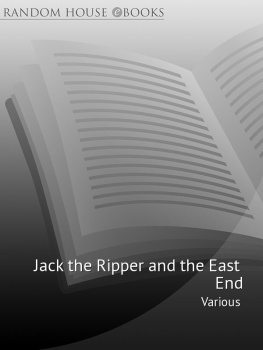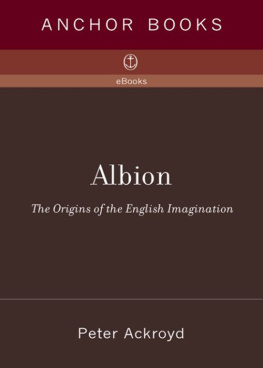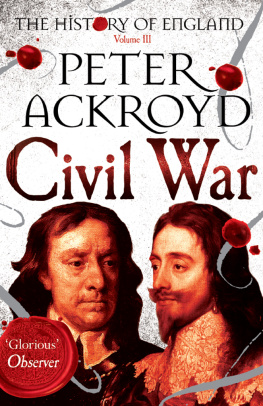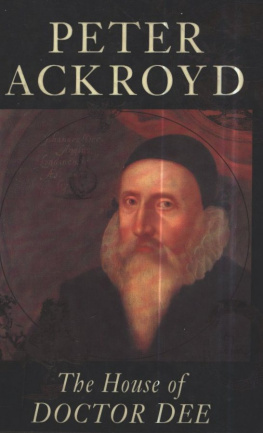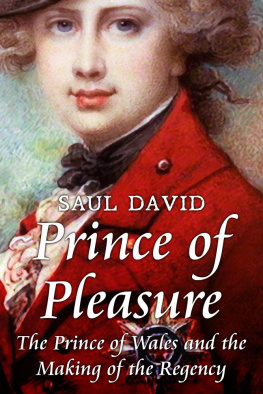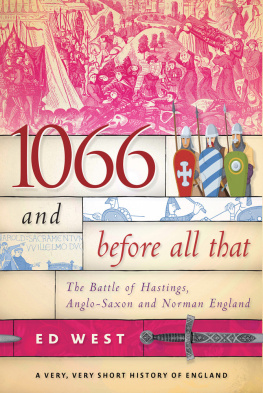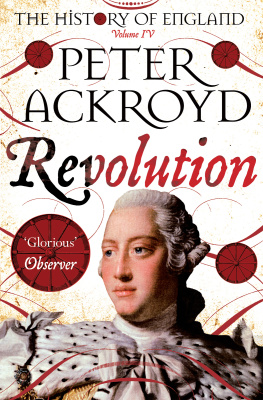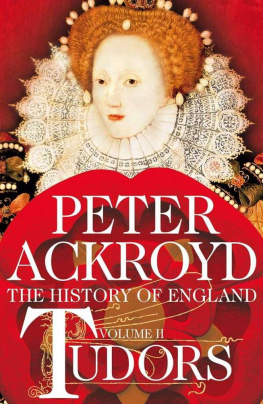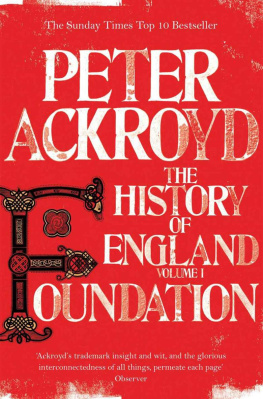Table of Contents
Guide
Peter Ackroyd
REVOLUTION
THE HISTORY OF ENGLAND
FROM THE BATTLE OF THE BOYNE
TO THE BATTLE OF WATERLOO
Thomas Dunne Books
St. Martins Press
New York

The author and publisher have provided this e-book to you for your personal use only. You may not make this e-book publicly available in any way. Copyright infringement is against the law. If you believe the copy of this e-book you are reading infringes on the authors copyright, please notify the publisher at: http://us.macmillanusa.com/piracy.
1. Ceiling of the Painted Hall, detail of King William III and Queen Mary II enthroned, c.170714 ( Royal Naval College, Greenwich, London, UK / Photo James Brittain / Bridgeman Images)
2. Portrait of Queen Anne, eighteenth century (Private Collection / Photo Philip Mould Ltd, London / Bridgeman Images)
3. Portrait of John Churchill, 1st Duke of Marlborough, by Godfrey Kneller, seventeenth century Private Collection / Bridgeman Images
4. The Battle of Blenheim on the 13th August 1704, c.1743 ( National Army Museum, London / acquired with assistance of National Art Collections Fund / Bridgeman Images)
5. Portrait of George I of England from the studio of Sir Godfrey Kneller, c.1754 (Photo by Apic/Getty Images)
6. Portrait of George II, eighteenth century ( The Trustees of the Goodwood Collection / Bridgeman Images)
7. Interior of a London coffee-house, c.16501750 ( Private Collection / Bridgeman Images)
8. Portrait of Sir Robert Walpole, eighteenth century ( Philip Mould Ltd, London / Bridgeman Images)
9. Portrait of William Pitt the Elder, later 1st Earl of Chatham (Private Collection / Photo Bonhams, London, UK / Bridgeman Images)
10. Portrait of Prince James Francis Edward Stuart the Old Pretender, c.1754 (Photo by Print Collector / Getty Images)
11. Prince Charles Edward Stuart, known as Bonnie Prince Charlie and the Young Pretender, c.1740 (Photo by Hulton Archive / Getty Images)
12. Emblematical print of the South Sea, illustration from Hogarth Restored: The Whole Works of the Celebrated William Hogarth, c.1812 ( Private Collection / The Stapleton Collection / Bridgeman Images)
13. The Spinning Jenny, invented by James Hargreaves in 1764, d.1870 ( Private Collection / Ken Welsh / Bridgeman Images)
14. A caricature of Gin Lane by William Hogarth, c.1750 (Photo by Culture Club/Getty Images)
15. A portrait of John Dryden by John Michael Wright, c.1668 ( Private Collection / Photo Philip Mould Ltd, London / Bridgeman Images)
16. A portrait of Jonathan Swift by Charles Jervas, c.1718 ( National Portrait Gallery, London, UK / Bridgeman Images)
17. A portrait of Alexander Pope from the studio of Godfrey Kneller, eighteenth century (Private Collection / Photo Philip Mould Ltd, London / Bridgeman Images)
18. A portrait of Dr. Samuel Johnson by Joshua Reynolds, eighteenth century ( Private Collection / Bridgeman Images)
19. King George III by Allan Ramsay, c.176264 (National Portrait Gallery, London, UK / Bridgeman Images)
20. Portrait of the Prince of Wales, late King George IV, c.1790 (Private Collection / Photo Philip Mould Ltd, London / Bridgeman Images)
21. The Iron Forge, c.1772 ( Broadlands Trust, Hampshire, UK / Bridgeman Images)
22. The Ball, from Scenes at Bath by Thomas Rowlandson ( Yale Center for British Art, Paul Mellon Collection, USA / Bridgeman Images)
23. A teapot from the Wedgwood Factory, Staffordshire, c.1775 ( Fitzwilliam Museum, University of Cambridge, UK / Bridgeman Images)
24. An engraving of the Boston Tea Party, 16th December 1773 ( Private Collection / Bridgeman Images)
25. A canvas of George Washington at Princeton, 1779 ( Pennsylvania Academy of the Fine Arts, Philadelphia, USA / Bridgeman Images)
26. William Pitt the Younger by Thomas Gainsborough, c.1788 ( The Iveagh Bequest, Kenwood House, London, UK / Historic England / Bridgeman Images)
27. The Impeachment, or The Father of the Gang turned Kings Evidence, published by S. W. Fores in 1791 ( Courtesy of the Warden and Scholars of New College, Oxford / Bridgeman Images)
28. A portrait of Samuel Taylor Coleridge, c.1804 ( Wordsworth Trust / Bridgeman Images)
29. A portrait of poet William Wordsworth, eighteenth century ( Wordsworth Trust / Bridgeman Images)
30. An etching of The Ancient of Days by William Blake, c.1794 ( Private Collection / Bridgeman Images)
31. A watercolour of people taking the waters at the pump room, Bath, c.1784 ( Victoria Art Gallery, Bath and North East Somerset Council / Bridgeman Images)
32. The Promenade at Carlisle House, c.1781 (Private Collection / Look and Learn / Peter Jackson Collection / Bridgeman Images)
33. A Modern Belle going to the Rooms at Bath, published by Hannah Humphrey in 1796 ( Courtesy of the Warden and Scholars of New College, Oxford / Bridgeman Images)
34. The Duchess of Richmonds Ball on 15 June 1815 ( The Trustees of the Goodwood Collection / Bridgeman Images)
35. The Battle of Trafalgar, c.1805 ( Muse de la Marine, Paris, France / J. P. Zenobel / Bridgeman Images)
36. An equestrian portrait of Napoleon c.1810 (Photo by DeAgostini / Getty Images)
37. The Duke of Wellington at Waterloo, nineteenth century ( Private Collection / Photo Christies Images / Bridgeman Images)

The king had fled, in the face of an invading army. Even though James II had reached the safety of France and William, prince of Orange, was ensconced in Whitehall, it was not at all clear who was the true sovereign of Britain. So a Convention, half way between an assembly of notables and a parliament, was called at the beginning of 1689. Since no recognized king was readily available to call an election it was a somewhat hasty and improvised affair; but it was not without the most important consequences. It marked a revolution in the affairs of state.
The Convenion met towards the end of January 1689 to consider the respective positions of James and William; there was at once a conference on the meanings of a throne deserted or vacant, a learned debate but one driven by the need to exclude for ever the absent king. The Commons finally declared that James II had abdicated, but there was no such term in law so this was essentially a legislative fiction. Yet there was no plausible alternative to the usurpers rule. As an authoritarian Catholic, James had been the worst possible monarch for a strongly Protestant nation. The fact that a group of notables had asked William of Orange to intervene in an increasingly fraught situation had granted a measure of legitimacy to the princes easy conquest. Yet he could not be seen as a king by conquest; that would bring back horrid memories of William I, whom good republicans loved to hate. So he had somehow to be proclaimed as king by right, a conveniently loose description that might cover almost any set of circumstances.
By the beginning of February a declaration of rights had been composed by the members of the Convention. One of its clauses forbade the establishment of a standing army in times of peace, regarded as one of the most obvious tokens of arbitrary royal power. Other clauses tended in the same direction. Laws could not be executed or suspended without the consent of parliament; taxes could not be raised for the benefit of the Crown without parliamentary agreement; freedom of speech in parliament was paramount and, in the final clause of the declaration, parliaments ought to be held frequently.


